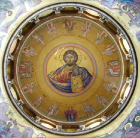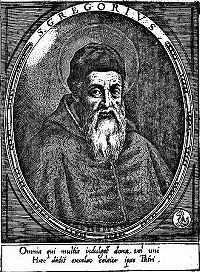Gregory of Nyssa
| Gregory of Nyssa | |
|---|---|
A medieval representation of Saint Gregory of Nyssa | |
| Born | ca. 335 in Caesarea in Cappadocia |
| Died | ca. 394 in Nyssa in Cappadocia |
| Venerated in | Eastern and Roman Catholicism, Eastern Orthodoxy, Oriental Orthodoxy, Anglicanism, Lutheranism |
| Feast | March 9 (Roman Catholicism); January 10 (Eastern Christianity and Lutheranism); March 9, June 14, or July 19 (Anglicanism) |
Gregory of Nyssa (Latin:Gregorius Nyssenus, Greek: Άγιος Γρηγόριος Νύσσης) (ca. 335–ca. 394) was a Christian bishop and saint. He was a younger brother of Basil the Great, and a good friend of Gregory Nazianzus. These three saints, collectively referred to as the Cappadocian Fathers, were instrumental in defining and defending Christian theology during a period of particularly volatile expansion (both orthodox and heretical). His significance has long been recognized in the Eastern Orthodox, Oriental Orthodox, and Roman Catholic branches of Christianity, all of whom celebrate his memory as part of the Calendar of Saints.
Biography
Gregory was born circa 335 C.E. at Caesarea Mazaca in Cappadocia. One of ten children, he came from a wealthy and pious family which produced a number of saints, including his father, Basil, his mother Emelia, grandmother Macrina the Elder, sister Macrina the Younger and brothers Basil and Peter, who became Bishop of Sebaste. Though existing records do not confirm this, it appears that Gregory was orphaned at a relatively young age, as he was raised by his elder siblings, Basil and Macrina. As suggested by Butler, these circumstances were evidently formative for the future saint: "in a letter to his younger brother Peter, Gregory speaks of Basil as 'our father and master', and throughout his life he looked up to him with the greatest affection and veneration."[1] After departing from his childhood home, Gregory received an exhaustive education in Athens and eventually accepted a post as a professor of rhetoric at a prestigious academy.[2] After remonstrations from both Basil and Gregory of Nazianzus, the younger Gregory eventually relented and accepted a posting as the bishop of Nyssa in 372 C.E.[3]
His brother Basil appointed him bishop in Nyssa because he wanted an episcopal ally near to his metropolitan see of Caesarea. He was present at the Council of Antioch, and later at the Second Ecumenical Council which took place in Constantinople. There he was a defender of the Nicene Creed against the Arians.[4]
Theology
Trinity
Gregory is remembered above all for two major contributions to theology. The first is his doctrine of the Trinity, a development of the theology of Basil and their mutual friend Gregory Nazianzus. Following Basil's lead, Gregory argues that the three Persons of the Trinity can be understood along the model of three members of a single class: thus, the Father, Son, and Holy Spirit are three in the same way that Peter, Paul, and Timothy are three men. So why do we not say there are three Gods? Gregory answers that, normally, we can distinguish between different members of the same class by the fact that they have different shapes, sizes, and colors. Even if they are identical, they still occupy different points in space. But none of this is true of incorporeal beings like God. Even lesser spiritual beings can still be distinguished by their varying degrees of goodness, but this does not apply to God either. In fact, the only way to tell the three Persons apart is by their mutual relations — thus, the only difference between the Father and the Son is that the former is the Father of the latter, and the latter is the Son of the former. As Gregory puts it, it is impossible to think of one member of the Trinity without thinking of the others too: they are like a chain of three links, pulling each other along.
Infinity
| Part of the series on Eastern Christianity | |

| |
|
History | |
|
Traditions | |
|
Liturgy and Worship | |
|
Theology | |
Gregory's second main contribution is his spiritual theology. He is the first Christian theologian to argue for the infinity of God and to contain a marked universalist tone. Origen, a major influence on Gregory, had explicitly argued that God is limited, an essential notion in Platonism, since to be limited is to be clearly defined and knowable. Gregory, however, argues that if God is limited he must be limited by something greater than himself. As there is nothing greater than God, He is therefore without boundaries, and thus infinite. The idea had already been developed by Neoplatonic philosophers, especially Plotinus, another important influence on Gregory, but he is the first Christian to defend it, apart from some hints in the work of Irenaeus.
Accordingly, Gregory argues that since God is infinite he cannot be comprehended. Origen had spoken of the spiritual journey as a progression of increasing illumination, as the mystic studies Scripture and comes to learn more about God. Nyssa taught on the other hand that God was knowable in his manifestations but that ultimately one must transcend knowledge or gnosis (since knowledge is based on reflection). Gnosis is limited and can become a barrier between man and God. If one wishes to commune with God one must have pure faith without any preconceived notions of God. Once one reaches this point one can commune with God just as Moses did in Nyssa's Life of Moses.
Stages of Spiritual Growth
Gregory speaks of three stages: initial darkness of ignorance, then spiritual illumination, and finally a darkness of the mind in contemplation of the God who cannot be comprehended.
Like earlier authors, including Philo, he uses the story of Moses as an allegory for the spiritual life. Moses first meets God in the burning bush, a theophany of light and illumination, but then he meets him again in the cloud, where he realizes that God cannot be seen by the eyes. Ascending Mount Sinai, he finally comes to the "divine darkness", and realizes that God cannot be known by the mind either.
It is only through not-knowing and not-seeing that God can, paradoxically, be known and seen. This notion would be extremely influential in both Western and Eastern spirituality, via the mystical writings of Pseudo-Dionysius the Areopagite, and later in the anonymous 14th century work, The Cloud of Unknowing. Thus, he is a major figure in the history of apophatic theology and spirituality.
Epektasis
Related to this is Gregory's idea of epektasis or constant progress. The platonic philosophy was that stability is perfection and change is for the worse. In contrast, Gregory described the ideal of human perfection as constant progress in virtue and godliness. In his theology, God himself has always been perfect and has never changed, and never will. Humanity fell from grace in the Garden of Eden, but rather than return to an unchanging state, humanity's goal is to become more and more perfect, more like God, even though humanity will never understand, much less attain, God's transcendence. This idea has had a profound influence on the Eastern Orthodox teaching regarding theosis or "divinization".
Gregory also taught that while it cannot be known whether or not all humans will be saved, as Origen speculated, faithful Christians may hope and pray for the salvation of all, even after death. He thus presents a hopeful alternative to those theologies, such as that of Augustine which state that at least some, of necessity, will be eternally condemned to hell.
Writings
Gregory's Trinitarian doctrine can be found in his Why there are not three Gods and in a letter to Basil which has been erroneously classified as Basil's 38th letter. His spiritual writings include Life of Moses, Life of Macrina (his older sister), the Life of Gregory Thaumaturgos, and 15 homilies On the Song of Songs. A large number of letters, sermons, philosophical works and short essays on a number of topics also survive.
See Also
- Cappadocian Fathers
- Gregory of Nazianzus
- Saint Basil
- Origen
- Eunomius of Cyzicus
Notes
ReferencesISBN links support NWE through referral fees
- Baring-Gould, S. (Sabine). The Lives of the Saints. With introduction and additional Lives of English martyrs, Cornish, Scottish, and Welsh saints, and a full index to the entire work. Edinburgh: J. Grant, 1914.
- Butler, Alban. Lives of the Saints. Edited, revised, and supplemented by Herbert Thurston and Donald Attwater. Palm Publishers, 1956.
- Farmer, David Hugh. The Oxford Dictionary of Saints. Oxford; New York: Oxford University Press, 1997. ISBN 0192800582.
- Leclercq, H. "St. Gregory of Nyssa" in the Catholic Encyclopedia. 1910.
- McGrath, Alister E. Historical Theology: An Introduction to the History of Christian Thought. Oxford: Blackwell Publishers, 1998. ISBN 0631208445.
- Pelikan, Jaroslav. Christianity and Classical Culture: The Metamorphosis of Natural Theology in the Christian Encounter with Hellenism. New Haven: Yale University Press, 1993. ISBN 0300062559.
- Tillich, Paul. A History of Christian Thought. Simon and Schuster, 1968. ISBN 0671214268.
External links
All sources retrieved September 23, 2007
- Gregory of Nyssa Home Page includes many English translations of his writings, with introductions
- Ethereal Classics Library 19th century translations of Gregory's most important works
Credits
New World Encyclopedia writers and editors rewrote and completed the Wikipedia article in accordance with New World Encyclopedia standards. This article abides by terms of the Creative Commons CC-by-sa 3.0 License (CC-by-sa), which may be used and disseminated with proper attribution. Credit is due under the terms of this license that can reference both the New World Encyclopedia contributors and the selfless volunteer contributors of the Wikimedia Foundation. To cite this article click here for a list of acceptable citing formats.The history of earlier contributions by wikipedians is accessible to researchers here:
The history of this article since it was imported to New World Encyclopedia:
Note: Some restrictions may apply to use of individual images which are separately licensed.
